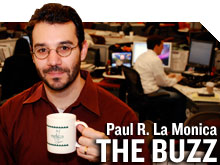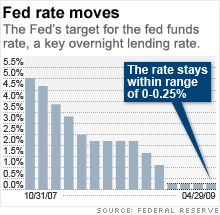Fed fights a losing battle on bonds
The central bank is buying U.S. Treasurys in order to keep long-term rates low. But yields are higher now than where they were before the purchases began.

 |
| The yield on the benchmark U.S 10-year is still lower than a year ago. But rates have crept higher in the past month -- even though the Fed has been buying Treasurys to try and keep rates low. |

NEW YORK (CNNMoney.com) -- So much for the Federal Reserve being able to hold long-term bond rates below 3%.
The Fed has been buying U.S. Treasury notes in the past month or so in order to keep a lid on long-term Treasurys, particularly the benchmark U.S. 10-year note. Bond prices and yields move in opposite directions. So more demand for bonds should lead to lower rates.
A day before the Fed said on March 18 that it would begin buying Treasurys, the yield on the 10-year was about 3%. Following the announcement, bonds rose and the yield fell to about 2.5% - exactly what the Fed wanted.
The Fed's success was temporary, though. On Wednesday, after the Fed reiterated it would finish purchasing $300 billion in Treasurys by this autumn, the 10-year sell-off continued. The note yielded 3.12%, the highest close of 2009.
"The bond market sold off because the Fed isn't changing the amount of bonds they are going to buy," said Brian Battle, vice president of Performance Trust Capital Partners. a fixed-income trading firm in Chicago.
"The bond market wants to test the Fed. There is a feeling that 3% is the magic number on the 10-year, so we'll see if the Fed tries to drive it back down to that level," Battle added.
Battle said yields could go as high as 3.25% in the short-term, especially if stocks continue to rally and more economic data suggests that the economy may be close to hitting bottom.
Steve Van Order, fixed income strategist for Calvert Funds in Bethesda, Md., agreed. "Fear has dropped, people are feeling better about the economy and are looking for higher yields," he said.
Rising bond yields are typically a sign of a strengthening economy, and yields rise to compensate for the risk of higher inflation.
This is key because the Fed has targeted long-term rates as a way to try and stimulate demand for loans. The central bank has already cut its federal funds rate, a key overnight bank lending rate, to near zero. So there's nothing more it can do on that end.
But long-term rates are arguably as important, if not more so, than the federal funds rate. That's because mortgage rates tend to track the movement of the 10-year.
To be sure, a 10-year yield of 3.1% is still relatively low by historical standards; the 10-year was yielding about 3.8% at this time a year ago. But if yields rise further, it could hurt the chances for an economic recovery.
One reason why many banks were able to post better-than-expected profits in the first quarter was that low rates fueled a refinancing boom. So if rates keep climbing, bank profits could be at risk.
It's clear that for the overall economy to recover, the housing market is going to need to bounce back.
Of course, low mortgage rates won't necessarily solve the problem of falling housing prices. But if cheap mortgages attract some first-time buyers to the market, it obviously will help.
Fortunately, the Fed has also been buying mortgage-backed securities. Van Order pointed out this is also been helping to keep mortgage rates down.
But as long as the stock market keeps rallying on hopes of a stabilizing economy, the 10-year yield could continue to head higher, which may eventually force the Fed to step up its Treasury purchases.
Van Order wondered, though, if the Fed really wants to pick a fight with the bond market.
"The size of the program is not enough to really affect rates. If the Fed really wanted to have an impact, it probably would need to buy at least $1 trillion in Treasurys," he said. "But how long can the fed fight that battle? It may not want to take on the bond market because it's just too big."
Want a Money Makeover? E-mail us at makeover@moneymail.com. For the CNNMoney.com Comment Policy, click here. ![]()

